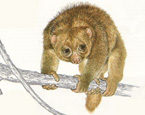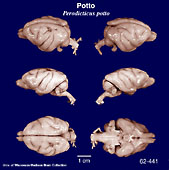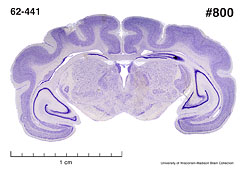|
Potto
Perodicticus potto
Head and body length is 305-390 mm, tail length is 37-100 mm.
Adults weigh between 850-1600 grams. Color ranges from brownish
gray to a rich, dark reddish brown. The underparts are slightly
lighter. The fur of the adult is thick and woolly. On the forehand,
the index finger is rudimentary, and the thumb is opposable
to the remaining three fingers, allowing the Potto to grasp
extremely well. The foot is equally adept at grasping, as the
large toe is opposable to the others. The second toe is slightly
shortened and has a long, sharp claw. All of the other digits
have flattened nails, similar to those of humans.
The vertebrae of the neck are very long and project above the
general contour of the flesh in this area. They are covered
by sensitive, hairless tubercles. It is believed that the function
is for tactile stimulation rather than for defense, aggression,
abrasion or muscular support.
P. potto prefers dense forest, and is usually found in trees
between 5-30 meters. It is arboreal and nocturnal, spending
its days sleeping in foliage. It moves slowly, but can make
quick grabs with its hands and mouth. The diet consists mainly
of fruits, but also includes some gums, insects, and small vertebrates
which it can kill, such as birds and bats. P. potto locates
much of its prey by smell.
Both male and female pottos are territorial. The females will
defend an area large enough to support herself and her offspring.
Older males establish home ranges which exclude the ranges of
other males, but may include the home ranges of one or more
females. Communication includes various vocalizations such as
a high pitched "tsic" between mother and young, a whistling
call by females in estrus, a threat groan, and a high pitched
distress call. Pottos also leave scent trails, presumably for
conspecifics, by urinating on branches.
The estrous cycle averages about 39 days with a gestation period
of about 170 days. There is usually one offspring, although
twins have been born in captivity. The young weighs 30-52 grams
at birth, and clings to its mothers belly for the first few
days of its life. Afterwards, it is left clinging to a hidden
branch at night with the mother forages, and picked up and returned
to the nest in the morning. At 3-4 months, the baby follows
the mother or rides on her back. Weaning takes place at 4-5
months, when fruit is most abundant. Adult weights is attained
at 8-14 months, sexual maturity is reached at 18 months.
P.potto is found in Cameroon to Guinea; Republic of Congo;
Gabon; Dem. Rep. Congo to W Kenya.
|



